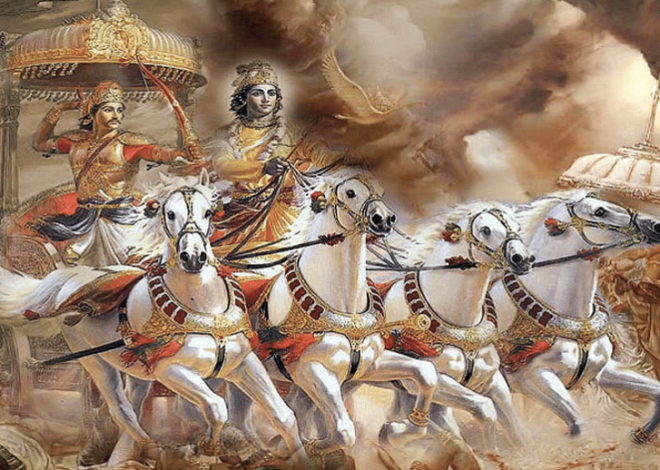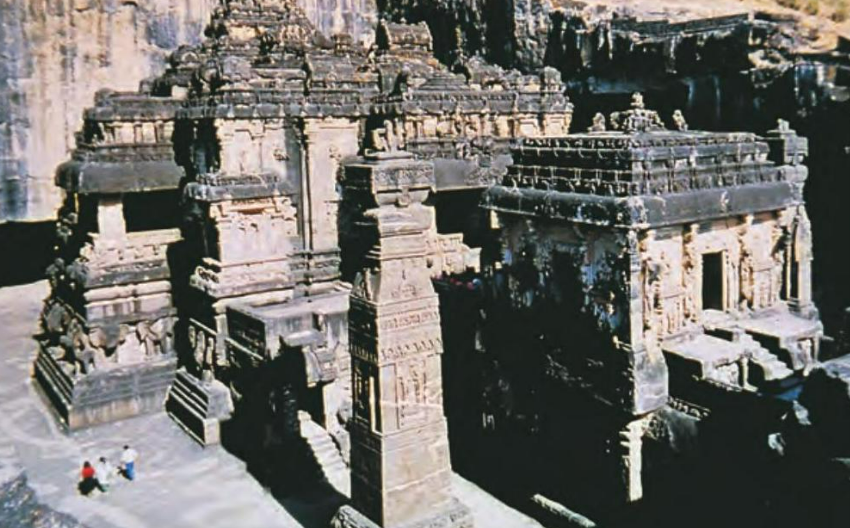
Cultural Developments: Early Thinkers, Beliefs and Buildings (600 BCE- 600 CE)
Thinkers are the people who thinks differently and they shape the society according to them. These thinkers were really important for the beautiful history of our country. Some famous thinkers born in India were Mahavira and Gautama Buddha.
They were the reason behind the cultural development we see in Indian history. So, here we will talk about these thinkers. Thinkers who brought changes in the society, thinkers who were calm and kind and the thinkers who were the reason behind our beautiful past.
Glimpse of Sanchi
Most wonderful ancient buildings were found at Sanchi Kanakhera in Bhopal. Alexander Cunningham, first Director General of Archaeological Survey of India stayed in the neighbourhood to study the remains and the ruins of buildings found at Sanchi. He made drawings of it and even deciphered the inscriptions.
Nineteenth century Europeans were interested in the stupa found at Sanchi. Shahjehan Begum who was the ruler of Bhopal forbade French and Englishmen to take the remains of stupa with them. Instead, she allowed them to take plaster cast copies with them.
When John Marshall came to study the remains and wrote the volumes, Sultan Jehan Begum (successor of Shahjehan Begum) funded the museum, ordered to build a guest house for John Marshall and shen even funded the publication of his volumes.
Sacrifices and Debates
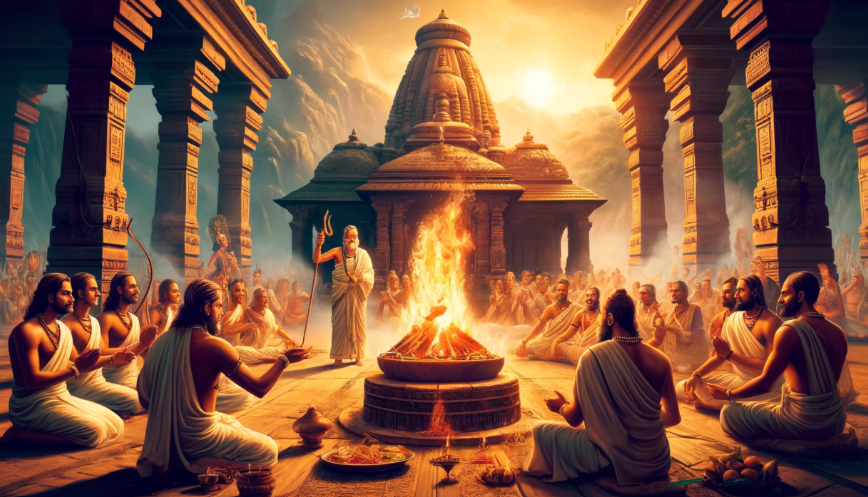
During mid millennium BCE (500 BCE onwards), different thinkers emerged in different parts of the world who shaped the society according to them. Some famous thinkers were:
- Zarathustra from Iran
- Kong Zi from China
- Popular thinkers of Greece were Socrates, Plato and Aristotle
- Famous religious thinkers of India were Mahavira and Buddha
Rigveda (written between 1500 BCE- 1000 BCE) contains some hymns about the Hindu deities like Indra, Agni and Soma that were chanted during sacrifices for the well being of sons, cattle and for good health and long life. Initially, sacrifices were performed collectively with all the members of the society but later (1000 BCE- 500 BCE) some sacrifices were performed by the head of the household.
Some sacrifices like Rajasuya and Ashvamedha were usually performed by the kings or the ruling families. Role of Brahmanas was really important as they were the ones who used to chant the hymns. During 6th century BCE, people were curious to know about the real meaning of life, they wanted to know about the life after death and about rebirth.
According to Buddhist texts, there were 64 sects or schools of thought. Teachers used to move from one place to another to convince one another with their ideas. Debates were held in the hut with a pointed roof known as kutagarashala. Members of defeated sect used to become the disciples or followers of the victorious sect.
The message of Mahavira
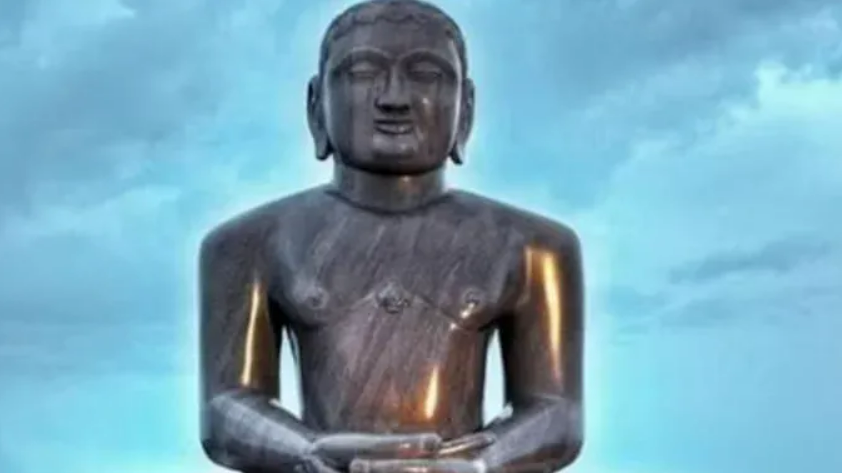
During 6th century BCE, the birth of a child named Vardhamana, who later came to be known as the Mahavira who was emerged as one of the famous religious thinkers. According to the Jaina tradition, Mahavira was not the one to establish the Jaina religion but he was the 24th tirthankara (those who used to guide people across the river of existence) or the teacher of Jainas.
According to Jaina ideas, every living and non living things have life. We should neither hurt living beings like animals, humans, plants, insects and microorganisms nor non living things like stones, water, etc. According to these ideas, the cycle of birth and rebirth is based on our actions or karma.
It was necessary for Jaina monks and nuns to take five vows to be a monk or nun. These vows were:
- They won’t steal anything
- Abstain from killing
- Never to lie
- Observe celibacy
- Will never possess property
Jainism spread in many parts of the subcontinent. Jaina literatures were written in different languages like Prakrit, Sanskrit and Tamil and these were preserved in the libraries attached to temples.
The journey of Buddha

Buddhism emerged in India was spread in many parts of the world. The message o this religion was spread in far off places like China, Korea and Japan in North and Eastern parts of the subcontinent and in south, to Sri Lanka, Myanmar, Indonesia and Thailand.
No ideas of Buddha were written in his life time but after the death of this religious thinker, his followers wrote down his ideas, came to be known as hagiographies. He had a long journey to be enlightened.
The birth name of Gautama Buddha was Siddhartha who was born as the son of the chief of Sakya clan. His father took him away from all the bad deeds of the world. He once went for his first journey which was really traumatic for him.
He saw an old man, a sick person and a corpse or a dead body. Then, he saw a homeless wanderer who had no fear of death and was satisfied with his life. Siddhartha decided to adopt that path of the homeless wanderer too.
He spent many days in search of enlightenment and finally after meditation, he achieved that enlightenment beneath the tree in Bodh Gaya. And for the rest of his life, he taught dhamma in different parts of India.
Teachings of Buddha
There are three volumes of Buddhist text:
- Vinaya Pitaka: contains the rules of behaviour for monks and nuns.
- Sutta Pitaka: contains the stories of Buddha’s life and the messages and ideas of Buddha
- Abhidhamma Pitaka
Sutta Pitaka was considered as the most important one as it contains all the ideas and teachings of Buddha. It also contains the stories about the life of Gautama Buddha in the regional languages, so that the ordinary people can easily understand the message behind the story.
According to Buddhist philosophy, the world is annicca or transient that means world changes continuously, there is nothing permanent in this world (annatta) and this transient world is full of sorrow or sadness depicted as “dukkha”.
According to Buddhist texts, people can get rid of the cycle of birth and rebirth through self indulgence and penance. People should meditate and should devote themselves in the worship of God. When the person’s ego and desire came to end, he/she can attain nibbana and self realization.
Followers of Buddha
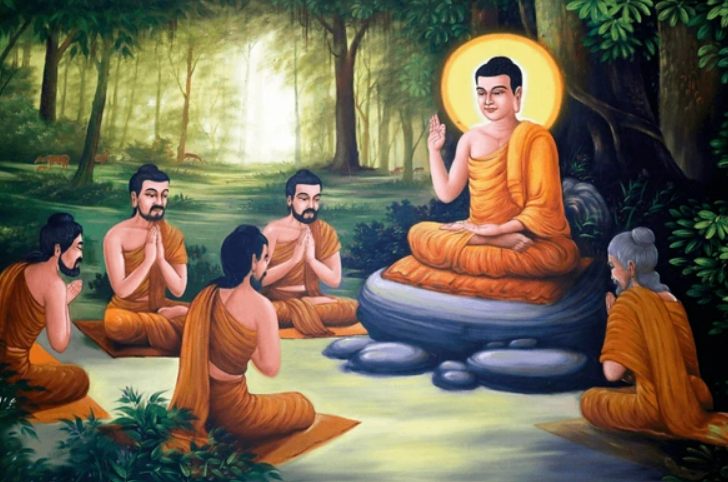
There were so many followers of Buddha who established an organisation of monks who also became the teachers of Buddhism. This organisation came to be known as sangha. Male members of this sangha were known as bhikkhus while women were known as bhikkhunis.
Initially, only men were allowed in the sangha but later women were also admitted. First women to be admitted into the sangha was Buddha’s foster mother, Mahapajapati Gotami. Many women followers were became teachers of Dhamma and who attained liberation came to be known as theris and their literature came to be known as therigatha, part of Sutta Pitaka. And the dearest disciple or follower of Buddha was Ananda.
Buddhism didn’t appreciate the practice of caste. So, any person either it is a king, farmer, merchant or even untouchable was considered as of equal status after they became the part of sangha. The only difference remained between them was of gender, females as bhikkhunis and males as bhikkhus.
Buddhists were against the superiority of one caste over other. The main teachings of Buddhism is metta or the fellow feeling and karuna or compassion. We should behave kindly with everyone especially with the weaker section of society.
Stupas
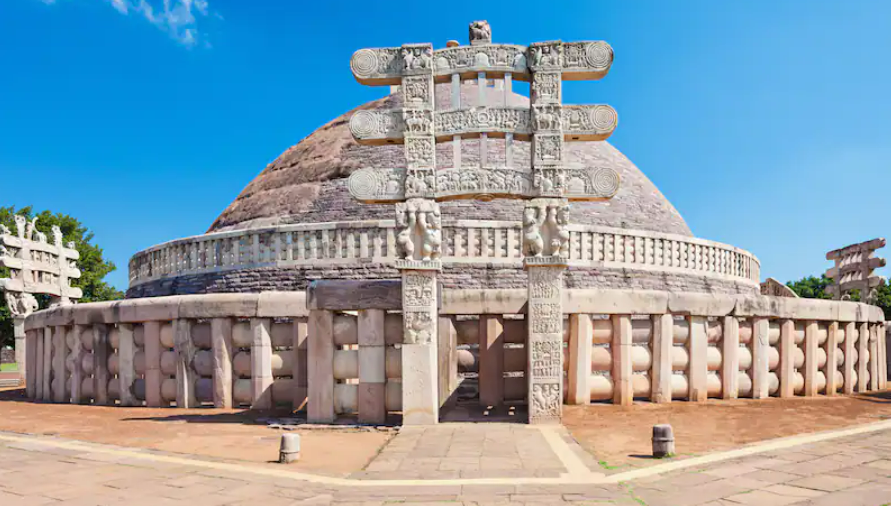
Stupas were the sacred place for Buddhists. The term “Chaitya” was derived from the word “chita” meaning a funeral pyre. Chaityas were the sacred places with small shrines. Buddhist literature describes about many chaityas or sacred places. Such as:
- The place where Buddha was born (Lumbini)
- The place where he attained enlightenment (Bodh Gaya)
- The place where he gave his first sermon (Sarnath)
- The place where he attained nibbana (Kusinagara)
Many kings, workers, bhikkhus, bhikkhunis and ordinary people donated either money or their labour to built stupas. Satavahana rulers also donated a part in it. According to Asokavandana, Asoka ordered to build stupas at Bharut, Sanchi and Sarnath.
There were several inscriptions found at gates and railings of stupas most commonly, depicting the stories about the life of Gautama Buddha and some stories were taken from Vedas, Jatakas and Panchtantra.
Structure of Stupa
“Stupa” is a Sanskrit word meaning heap. Initially, stupas were a semi circular mound called anda. Gradually, the structure became more complex. Over anda, a balcony like structure was built known as harmika which was considered as the abode of god.
A pole like structure was built over harmika called yashthi and the umbrella like structure over yashthi came to be known as chhatri. Stupas are the sacred place for Buddhists. The boundary of Stupa separate the sacred world (stupa- abode of god) from the secular world (materialistic world).
There were four gateways to enter the stupa known as toranadwara. Worshippers used to enter into the stupa from the eastern gateway and used to walk into the clockwise direction. Later, more elaborations were seen on the mounds at Amravati and at Shah-ji-ki-dheri (in present day Pakistan).
The fate of Amravati
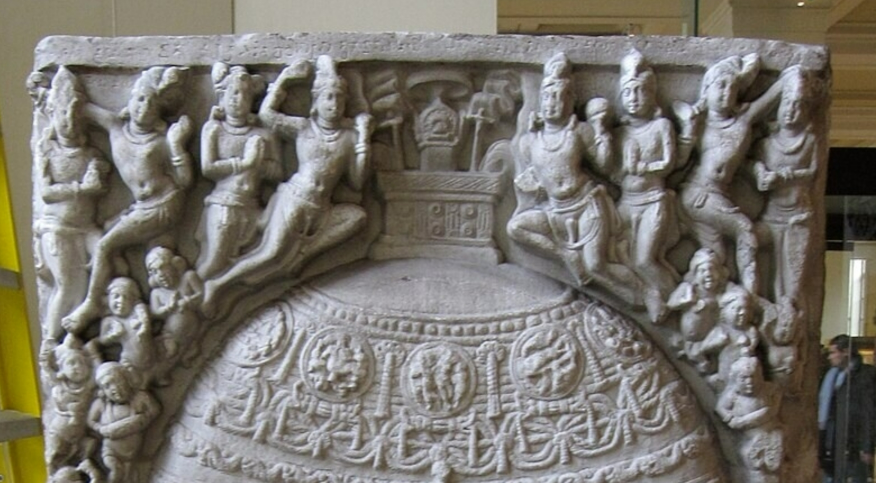
In 1796, a local king passed an order to build a temple and for this, he ordered his men to find better stones. The soldiers took the slabs of stupa at Amravati to build a temple as they thought it was just a mound and they didn’t knew the importance of it.
Then, Colin Mackenzie, a British official made detailed drawings of the stupa at Amravati but his reports were never published. Then, in 1854, Walter Elliot who was the commissioner of Guntur (Andhra Pradesh) took sculptures to Madras and he also founded the western gateway and concluded that the stupa of Amravati was the largest and the most beautiful stupa in the world.
In 1850s, many slabs and sculptures were taken to Asiatic Society of Bengal at Calcutta, to India Office in Madras and some were even taken to London. An archaeologist named H.H.Cole wrote in his account that the real things should be preserved at its real location also known as in-situ preservation. If anyone want, then they can take the plaster cast copies with them.
A question arises why Sanchi survived while Amravati did not? Stupa of Amravati was discovered before we knew the importance of it while Sanchi was discovered in 1818 and protected by the rulers of Bhopal (Shahjehan Begum and Sultan Jehan Begum). It was found in good condition with three gateways at their place and the fourth gateway was lying on the place where it fell.
Sculptures
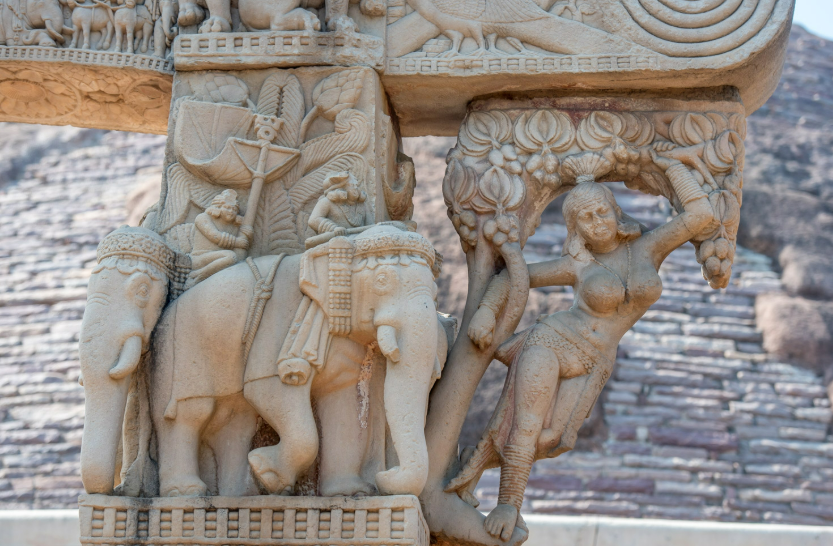
Early wandering storytellers used to carry scrolls with them known as charanchitras. These were painted on cloths and papers. Historians studied the inscriptions on the gateway of stupa at Sanchi and concluded that it depicts the scene from Vessantara Jataka. According to this story, a prince gave everything to a Brahmana and went to live into the forest with his wife and children.
Initially, Buddha was not represented in human form. Instead, some symbols were used to represent Buddha. Some of the symbols used to denote the part of Buddha’s life were:
- The empty seat used to indicate the meditation phase of Buddha’s life
- Wheel indicates the first sermon of Buddha at Sarnath
- Stupa indicates Mahaparinibbana
Some sculptures which had no connection with Buddha’s life were also found at Sanchi like a sculpture of a beautiful woman swinging on the branch of a tree at the edge of one of the gateway of stupa at Sanchi known as the sculpture of Shalabhanjika. According to a myth, her single touch could make the flower to bloom.
Animal motifs were found on the gateway of Stupa taken from the animal stories of Jataka. Each and every animal used to have a link with human attributes like elephant used to indicate the strength and wisdom. Horse used to indicate the speed. Some other animals were also used in the story like monkey, fox, cattle, etc. Many other motifs were also found such as:
A woman surrounded with elephants and lotuses. Elephants were sprinkling water on her was considered to be the mother of Buddha, Maya who is a popular goddess in Hinduism known as Gajalakshmi, the goddess of good fortune and wealth.
Motif of a serpent was also found there. James Fergusson, who was the earliest modern art historian concluded that Sanchi was the centre of tree and serpent worship.
New Religious Traditions
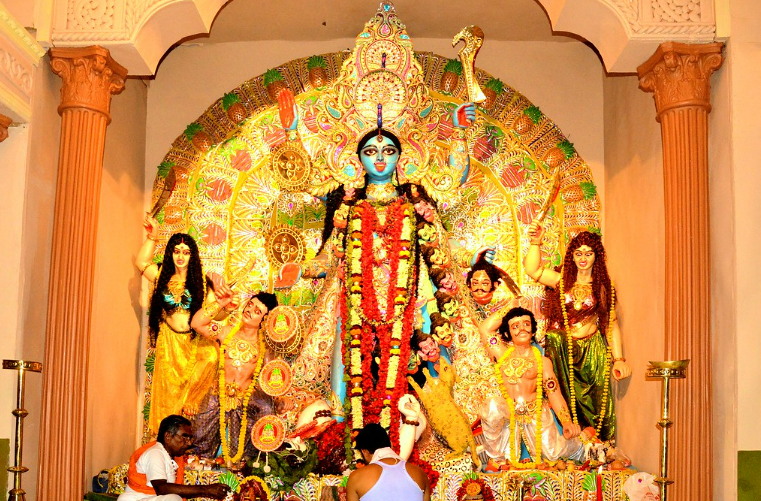
Gradually, from 1st century BCE, idea of saviour and the concept of Bodhisattas emerged. Bodhisattas were the people who were compassionate and kind, who helped others to attain nibbana. Gradually, some new traditions and beliefs were added on. People started to worship the images of Buddha and Bodhisattas.
People who used to follow new beliefs were known as “Mahayana” or “the great vehicle” while others who used to follow the older beliefs came to be known as “Hinayana” or “the lesser vehicle”. The notion of saviour was not unique in Buddhism.
We found the evidences of this concept in Hinduism too which was prevalent from the earliest times. Vaishnavism (worship of Lord Vishnu as the chief deity) and Shaivism (worship of Lord Shiva as the chief deity) was also prevalent at that time. Lord Shiva was also worshipped in the form of Linga which we see in the present world too.
We all know about the ten avatars or incarnations of Lord Vishnu. It is believed that the local deities were recognised as the form o Lord Vishnu to form a more unified religious tradition. So many sculptures of Hindu deities were found with head dresses, ornaments and ayudhas or weapons and objects deities hold in their hands.
To understand these sculptures, historians took help from Puranas, compiled by Brahmanas in first millennium CE in simple Sanskrit so that the ordinary people can also understand the meaning of it, especially women and Shudras because they had no access to Vedic learning. Now, at least they could understand their tradition through listening.
Now, let’s talk about early temples and shrines. Initially, temples were built as a small room with the image of gods or goddesses known as garbhagriha. Later, shikhara was built over the main shrine. Then, gradually the structure of the temples became complex.
With time, major changes were brought into the structure. Huge halls, huge walls and gateways were built and the water arrangements were made. Not only this, after some time, huge magnificent temples were built were carving the rocks and by hollowed out the huge rocks. Asoka ordered the people of Ajivika sect to build a temple by carving out the whole mountain which is now very popular in the world known as Kailashnatha Temple in Maharashtra.
Something unfamiliar
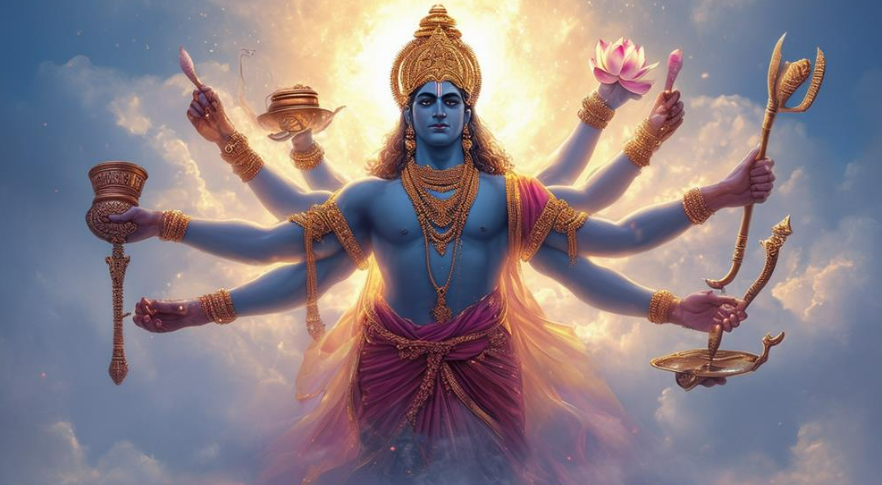
European scholars found many other sculptures which were unfamiliar to them. Yes, these sculptures were of Hindu deities. The sculptures with multiple arms and heads were found. Some sculptures were the combination of human and animal forms like Varaha avatar and Narasimha avatar of Lord Vishnu.
Some sculptures of Buddha and Bodhisattas were also found whose appearance vary from place to place. Sculptures found in northwest part of India where Indo-Greek rulers established their kingdom was different from the sculptures found in other parts of the country.
Some sculptures were shown wearing a long cloth covering the whole body while some were shown half naked wearing a loincloth only or known as dhoti in Hindi. Famous sculpture found at Mahabalipuram (Tamil Nadu) depicting the scene of Ganga river.
This scene was probably taken either from Puranas or from Mahabharata. It most commonly seems like Arjuna doing penance or meditation near the bank of Ganga river.
More historical articles:


